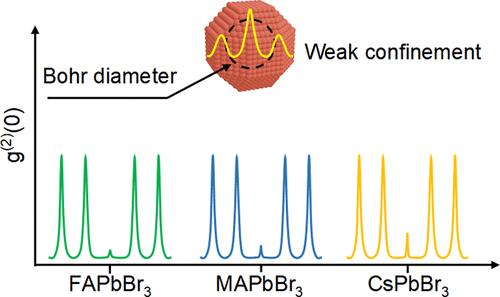Our official English website, www.x-mol.net, welcomes your
feedback! (Note: you will need to create a separate account there.)
Weakly Confined Organic–Inorganic Halide Perovskite Quantum Dots as High-Purity Room-Temperature Single Photon Sources
ACS Nano ( IF 15.8 ) Pub Date : 2024-04-10 , DOI: 10.1021/acsnano.3c12311
Bo Wang 1 , Jia Wei Melvin Lim 1 , Siow Mean Loh 2 , Rishikanta Mayengbam 1 , Senyun Ye 1 , Minjun Feng 1 , Huajun He 1 , Xiao Liang 3 , Rui Cai 1 , Qiannan Zhang 1 , Leong-Chuan Kwek 4, 5 , Hilmi Volkan Demir 1, 3, 6 , Subodh G Mhaisalkar 7, 8 , Steven A Blundell 2 , Tze Chien Sum 1
ACS Nano ( IF 15.8 ) Pub Date : 2024-04-10 , DOI: 10.1021/acsnano.3c12311
Bo Wang 1 , Jia Wei Melvin Lim 1 , Siow Mean Loh 2 , Rishikanta Mayengbam 1 , Senyun Ye 1 , Minjun Feng 1 , Huajun He 1 , Xiao Liang 3 , Rui Cai 1 , Qiannan Zhang 1 , Leong-Chuan Kwek 4, 5 , Hilmi Volkan Demir 1, 3, 6 , Subodh G Mhaisalkar 7, 8 , Steven A Blundell 2 , Tze Chien Sum 1
Affiliation

|
Colloidal perovskite quantum dots (PQDs) have emerged as highly promising single photon emitters for quantum information applications. Presently, most strategies have focused on leveraging quantum confinement to increase the nonradiative Auger recombination (AR) rate to enhance single-photon (SP) purity in all-inorganic CsPbBr3 QDs. However, this also increases the fluorescence intermittency. Achieving high SP purity and blinking mitigation simultaneously remains a significant challenge. Here, we transcend this limitation with room-temperature synthesized weakly confined hybrid organic–inorganic perovskite (HOIP) QDs. Superior single photon purity with a low g(2)(0) < 0.07 ± 0.03 and a nearly blinking-free behavior (ON-state fraction >95%) in 11 nm FAPbBr3 QDs are achieved at room temperature, attributed to their long exciton lifetimes (τX) and short biexciton lifetimes (τXX). The significance of the organic A-cation is further validated using the mixed-cation FAxCs1–xPbBr3. Theoretical calculations utilizing a combination of the Bethe–Salpeter (BSE) and k·p approaches point toward the modulation of the dielectric constants by the organic cations. Importantly, our findings provide valuable insights into an additional lever for engineering facile-synthesized room-temperature PQD single photon sources.
中文翻译:

弱限域有机-无机卤化物钙钛矿量子点作为高纯度室温单光子源
胶体钙钛矿量子点(PQD)已成为量子信息应用中极具前景的单光子发射器。目前,大多数策略都集中在利用量子限制来提高非辐射俄歇复合 (AR) 速率,从而提高全无机 CsPbBr 3量子点的单光子 (SP) 纯度。然而,这也增加了荧光间歇性。同时实现高 SP 纯度和闪烁缓解仍然是一个重大挑战。在这里,我们通过室温合成的弱限制杂化有机-无机钙钛矿(HOIP)量子点超越了这一限制。 11 nm FAPbBr 3 QD 在室温下实现了卓越的单光子纯度、低g (2) (0) < 0.07 ± 0.03 和几乎无闪烁行为(ON 状态分数 >95%),这归因于其长激子寿命 ( τ X ) 和短双激子寿命 ( τ XX )。使用混合阳离子 FA x Cs 1– x PbBr 3进一步验证了有机 A-阳离子的重要性。结合 Bethe-Salpeter (BSE) 和k·p方法进行的理论计算表明有机阳离子可以调节介电常数。重要的是,我们的研究结果为设计易于合成的室温 PQD 单光子源的额外杠杆提供了宝贵的见解。
更新日期:2024-04-10
中文翻译:

弱限域有机-无机卤化物钙钛矿量子点作为高纯度室温单光子源
胶体钙钛矿量子点(PQD)已成为量子信息应用中极具前景的单光子发射器。目前,大多数策略都集中在利用量子限制来提高非辐射俄歇复合 (AR) 速率,从而提高全无机 CsPbBr 3量子点的单光子 (SP) 纯度。然而,这也增加了荧光间歇性。同时实现高 SP 纯度和闪烁缓解仍然是一个重大挑战。在这里,我们通过室温合成的弱限制杂化有机-无机钙钛矿(HOIP)量子点超越了这一限制。 11 nm FAPbBr 3 QD 在室温下实现了卓越的单光子纯度、低g (2) (0) < 0.07 ± 0.03 和几乎无闪烁行为(ON 状态分数 >95%),这归因于其长激子寿命 ( τ X ) 和短双激子寿命 ( τ XX )。使用混合阳离子 FA x Cs 1– x PbBr 3进一步验证了有机 A-阳离子的重要性。结合 Bethe-Salpeter (BSE) 和k·p方法进行的理论计算表明有机阳离子可以调节介电常数。重要的是,我们的研究结果为设计易于合成的室温 PQD 单光子源的额外杠杆提供了宝贵的见解。































 京公网安备 11010802027423号
京公网安备 11010802027423号